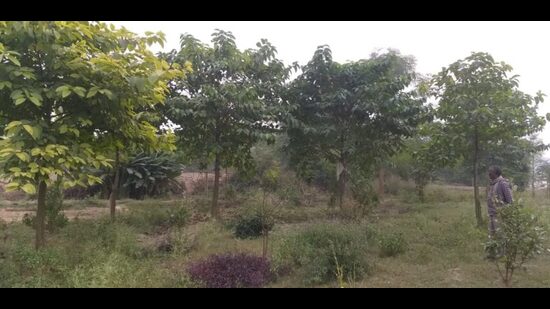From barren & dry to lush green: Firozabad dist admin, locals develop micro-forest along Lucknow-Agra e-way
The idea behind this micro-forest -- between Firozabad and Agra -- was conceived by the then Firozabad district magistrate Neha Sharma.
LUCKNOW Once a stretch of barren non-fertile land, an area of five acres has now become Firozabad’s first line of defence against pollution. In less than five years, the Firozabad district administration, along with the help of locals, has been able to transform the dry and termite-infested land along the Lucknow-Agra expressway by turning it into a micro-forest.

The idea behind this micro-forest -- between Firozabad and Agra -- was conceived by the then Firozabad district magistrate Neha Sharma. Initially, the district administration identified an ochre-dry acre of land for the project near the Yamuna river bank in Jalalpur village. Sharma visited the place many times with her team of associated officers, including those from the forest department.
On July 15, 2018, the forest department planted 150 tree saplings across the length and breadth of the identified land. Slowly and gradually, the efforts started bearing fruits. Buoyed by the success, the locals in the area also started planting saplings. By July 2019, the total plantation area spread to 5 acres.
“The saplings have now become trees and biodiversity is flourishing,” says Prabhat Mishra, the then assistant director, National Savings, Firozabad. He also had the additional charge of the block development officer (BDO). Prabhat, who is also an environmentalist, worked on the project with Neha Sharma’s team.
“Neha Sharma was determined to make the project a success. While the idea was extremely challenging given the land profile, she requisitioned local support, and asked a local farmer Rambabu to look after the project when it was limited to one acre.”
Equipped with some traditional knowledge of how to manage plants in dry and termite-infested areas, Rambabu regularly poured a turmeric and sugar solution into the roots of the saplings to hydrate and protect them from pests. The sugar in the solution was to attract ants that ate termites, and that’s how most of the saplings grew.
In fact, Rambabu began living in the plantation area 24X7 to guard the saplings against any potential thieves and cattle. Seeing a positive outcome, many more people came forward to help. Meanwhile, Neha Sharma and Prabhat Mishra were given different postings.
When the plantation spread to 5 acres, the former village head Sonu Gurjar deployed his agriculture machines and pumps to irrigate the trees. Slowly, the biodiversity of the place started flourishing. Birds, reptiles, mammals, bees, butterflies, and many more animals made the micro-forest their habitat.
As the patch turned green, it attracted an ascetic and his followers too. They made the micro-forest their home. The relationship soon turned symbiotic. “For the last three years, Pagal Das Baba and his followers have been living in this area. They also take care of the plants. They have helped improve the region’s biodiversity. They spread awareness about environmental protection amongst the local villagers and other visitors”, said Prabhat.
Vijay Tenguriya, branch manager of a local bank, also joined hands as the project met success. He planted many saplings and started donating diesel for the pump set for irrigating the trees. He also provided manure. “Today, more than 90% of the planted saplings are thriving as trees. Currently, there are 500 trees on the land -- including peepul, banyan, neem, lemon, and others. There are some mango trees as well even as not all the mango saplings survived,” said Prabhat Mishra, who visited the micro-forest just last week.
Speaking on the micro-forest, Pagal Das Baba said, “Nature has no gardener, no painter; but look how these varied leaves of varied greens paint the surroundings beautifully. This is divine and thus, we worship trees by taking care of them. We also look after any new saplings that are planted here.”






